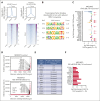BRG1/BRM inhibitor targets AML stem cells and exerts superior preclinical efficacy combined with BET or menin inhibitor
- PMID: 38437498
- PMCID: PMC11830987
- DOI: 10.1182/blood.2023022832
BRG1/BRM inhibitor targets AML stem cells and exerts superior preclinical efficacy combined with BET or menin inhibitor
Abstract
BRG1 (SMARCA4) and BRM (SMARCA2) are the mutually exclusive core ATPases of the chromatin remodeling BAF (BRG1/BRM-associated factor) complexes. They enable transcription factors/cofactors to access enhancers/promoter and modulate gene expressions responsible for cell growth and differentiation of acute myeloid leukemia (AML) stem/progenitor cells. In AML with MLL1 rearrangement (MLL1r) or mutant NPM1 (mtNPM1), although menin inhibitor (MI) treatment induces clinical remissions, most patients either fail to respond or relapse, some harboring menin mutations. FHD-286 is an orally bioavailable, selective inhibitor of BRG1/BRM under clinical development in AML. Present studies show that FHD-286 induces differentiation and lethality in AML cells with MLL1r or mtNPM1, concomitantly causing perturbed chromatin accessibility and repression of c-Myc, PU.1, and CDK4/6. Cotreatment with FHD-286 and decitabine, BET inhibitor (BETi) or MI, or venetoclax synergistically induced in vitro lethality in AML cells with MLL1r or mtNPM1. In models of xenografts derived from patients with AML with MLL1r or mtNPM1, FHD-286 treatment reduced AML burden, improved survival, and attenuated AML-initiating potential of stem-progenitor cells. Compared with each drug, cotreatment with FHD-286 and BETi, MI, decitabine, or venetoclax significantly reduced AML burden and improved survival, without inducing significant toxicity. These findings highlight the FHD-286-based combinations as a promising therapy for AML with MLL1r or mtNPM1.
© 2024 American Society of Hematology. Published by Elsevier Inc. All rights are reserved, including those for text and data mining, AI training, and similar technologies.
Conflict of interest statement
Conflict-of-interest disclosure: K.N.B. has received research funding from Iterion, Foghorn, and Nurix Pharmaceuticals; and serves as a consultant for Iterion Therapeutics. J.P., M.C., and M.H. are employed by Foghorn Therapeutics. R.S. is an employee of Active Motif. The remaining authors declare no competing financial interests.
Figures









References
-
- Centore RC, Sandoval GJ, Soares LMM, Kadoch C, Chan HM. Mammalian SWI/SNF chromatin remodeling complexes: emerging mechanisms and therapeutic strategies. Trends Genet. 2020;36(12):936–950. - PubMed
-
- Otto JE, Ursu O, Wu AP, et al. Structural and functional properties of mSWI/SNF chromatin remodeling complexes revealed through single-cell perturbation screens. Mol Cell. 2023;83(8):1350–1367.e7. - PubMed
-
- Pulice JL, Kadoch C. Composition and function of mammalian SWI/SNF chromatin remodeling complexes in human disease. Cold Spring Harb Symp Quant Biol. 2016;81:53–60. - PubMed
Publication types
MeSH terms
Substances
Grants and funding
LinkOut - more resources
Full Text Sources
Medical
Miscellaneous

